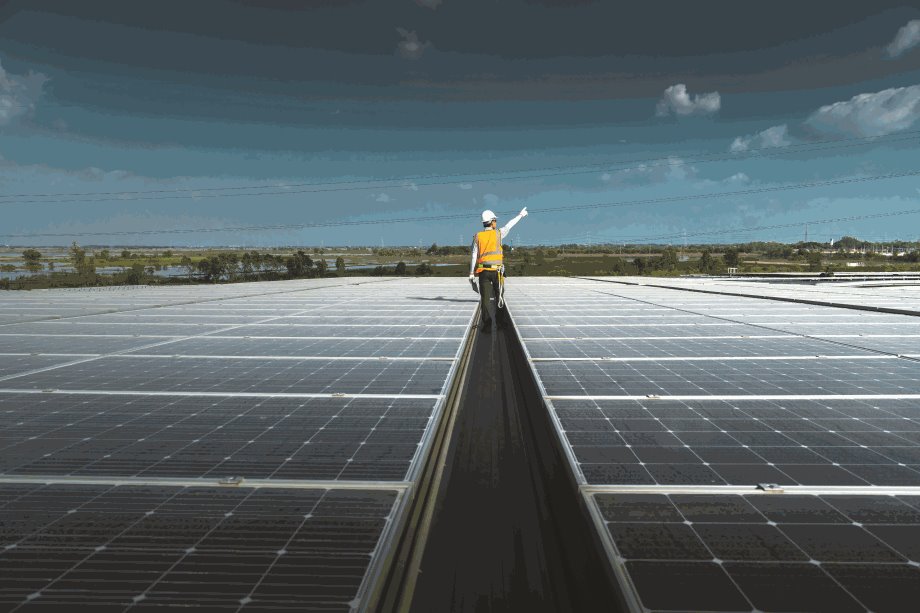Green Power Employment Outlook
Green Power Employment Outlook


The zero-carbon power sector is growing, but which fields provide the most job opportunities?
The United States has ambitious plans to convert the electric industry, which had long been dominated by coal power plants, into a zero-carbon-emissions economic sector by 2035. Accomplishing that will require building out gigawatts of generating capacity involving wind, solar, nuclear, and other emissions-free power technologies.
All that activity should increase the number of jobs in the green power sector. The U.S. Bureau of Labor Statistics (BLS) produces annual employment projections across hundreds of industries, from accommodation and food services to wood products, and nearly a thousand occupations. The projections, which are based on demographic trends, economic forecasts, and historical relationships, are designed to assist in identifying skills gaps and opportunities from worker training.
According to an October 2023 report accompanying the most recent data release, “The clean energy transition is expected to be the main driver of fast growth for 4 of the top 15 fastest growing industries and 2 of the top 15 fastest growing occupations.”
That said, some clean-energy industries are growing faster than others, which others that are seeing healthy percentage increases in employment are starting from a relatively low base. Here is what the BLS employment projections reveal for six green energy industries, listed from least number of jobs to most. Note, however, that these numbers only include the jobs within the larger electric utility sector and don’t capture fully the impact across the entire economy.
Employment in 2022: 1,200
Employment in 2032: 1,900
Geothermal starts from a low employment base, but it is poised for growth. Some experts believe geothermal has the potential to power much or all the economy, and recent work by companies that apply hydraulic fracturing technology to crack hot, deep rocks suggests geothermal is viable in most parts of the world.
For more on geothermal, listen to our podcast
Employment in 2022: 2,000
Employment in 2032: 2,000
Power plants have used biomass, such as waste wood, as fuel for decades. While it is a zero-net-carbon fuel, some experts question whether using biomass to produce electricity rather than liquids such as ethanol or sustainable aviation fuel. The BLS projects employment in the biomass electric power industry to be flat (or slightly declining) over the next ten years.
Employment in 2022: 7,500
Employment in 2032: 7,200
The United States has long relied on hydropower to generate large quantities of clean, reliable electricity. Unfortunately, dams such as Grand Coulee and Hoover can only be built once, and the locations to add new dams have dwindled. The BLS sees employment declining in this industry, mostly due to cuts in plant operations and office support as many processes that once required human workers become automated.
Employment in 2022: 8,000
Employment in 2032: 12,900
Wind power has witnessed tremendous growth over the past 20 years, and the BLS expects that to continue. In fact, wind turbine service technician is projected to be the fastest growing job in the U.S. economy, increasing from 11,200 jobs to 16,200 jobs across all industry sectors. Not all wind-power jobs are found within the BLS definition of the wind electric power industry, but even so, the 60 percent increase in employment makes it one of the fastest growing industries over the next ten years.
Employment in 2022: 8,400
Employment in 2032: 13,500
The biggest growth in clean energy jobs is projected to be seen in the solar industry, which is projected to add more than 5,000 positions in the utility sector alone. According to the BLS, the number of solar photovoltaic installers across the entire economy will jump from 29,400 in 2022 to 35,900 in 2032, with most of those workers being assigned to the companies listed as building equipment contractors rather than the solar electric industry. The BLS also expects the number of engineers employed by the solar electric power industry to rise by nearly 56 percent.
Employment in 2022: 37,100
Employment in 2032: 35,200
Many people don’t think of nuclear power as clean energy, but it produces reliable baseload electricity without carbon emissions. The nuclear electric power industry employs about as many workers as the other green-power industries combined—at least at the utility level—and 6,500 engineers. A lack of new reactors coming online over the next decade hurts employment prospects, however, with the BLS projecting a 5 percent decline in jobs by 2032. Things may turn around if new technologies such as small modular reactors (SMRs) or even nuclear fusion catch on in the 2030s.
In contrast to the green power industry, there’s not much good news for fossil fuel power jobs in the BLS projections. “Employment in fossil fuel electric power generation is projected to decline by 35.4 percent from 2022 to 2032,” the BLS reports. “This is the third-steepest decline of all industries.” While the BLS expects fossil fuels will still have a place in the power industry in 2032, the rapid decline in jobs there and in associated industries such as coal mining (a 43 percent decline in jobs there) suggest that sector will fading fast in ten years’ time.
The BLS provides employment forecasts for every industry.
Jeffrey Winters is editor in chief of Mechanical Engineering magazine.

All that activity should increase the number of jobs in the green power sector. The U.S. Bureau of Labor Statistics (BLS) produces annual employment projections across hundreds of industries, from accommodation and food services to wood products, and nearly a thousand occupations. The projections, which are based on demographic trends, economic forecasts, and historical relationships, are designed to assist in identifying skills gaps and opportunities from worker training.
According to an October 2023 report accompanying the most recent data release, “The clean energy transition is expected to be the main driver of fast growth for 4 of the top 15 fastest growing industries and 2 of the top 15 fastest growing occupations.”
That said, some clean-energy industries are growing faster than others, which others that are seeing healthy percentage increases in employment are starting from a relatively low base. Here is what the BLS employment projections reveal for six green energy industries, listed from least number of jobs to most. Note, however, that these numbers only include the jobs within the larger electric utility sector and don’t capture fully the impact across the entire economy.
Geothermal electric power
Employment in 2022: 1,200Employment in 2032: 1,900
Geothermal starts from a low employment base, but it is poised for growth. Some experts believe geothermal has the potential to power much or all the economy, and recent work by companies that apply hydraulic fracturing technology to crack hot, deep rocks suggests geothermal is viable in most parts of the world.
For more on geothermal, listen to our podcast
Biomass electric power
Employment in 2022: 2,000Employment in 2032: 2,000
Power plants have used biomass, such as waste wood, as fuel for decades. While it is a zero-net-carbon fuel, some experts question whether using biomass to produce electricity rather than liquids such as ethanol or sustainable aviation fuel. The BLS projects employment in the biomass electric power industry to be flat (or slightly declining) over the next ten years.
Hydroelectric power
Employment in 2022: 7,500Employment in 2032: 7,200
The United States has long relied on hydropower to generate large quantities of clean, reliable electricity. Unfortunately, dams such as Grand Coulee and Hoover can only be built once, and the locations to add new dams have dwindled. The BLS sees employment declining in this industry, mostly due to cuts in plant operations and office support as many processes that once required human workers become automated.
Wind electric power
Employment in 2022: 8,000Employment in 2032: 12,900
Wind power has witnessed tremendous growth over the past 20 years, and the BLS expects that to continue. In fact, wind turbine service technician is projected to be the fastest growing job in the U.S. economy, increasing from 11,200 jobs to 16,200 jobs across all industry sectors. Not all wind-power jobs are found within the BLS definition of the wind electric power industry, but even so, the 60 percent increase in employment makes it one of the fastest growing industries over the next ten years.
Solar electric power
Employment in 2022: 8,400Employment in 2032: 13,500
The biggest growth in clean energy jobs is projected to be seen in the solar industry, which is projected to add more than 5,000 positions in the utility sector alone. According to the BLS, the number of solar photovoltaic installers across the entire economy will jump from 29,400 in 2022 to 35,900 in 2032, with most of those workers being assigned to the companies listed as building equipment contractors rather than the solar electric industry. The BLS also expects the number of engineers employed by the solar electric power industry to rise by nearly 56 percent.
Nuclear electric power
Employment in 2022: 37,100Employment in 2032: 35,200
Many people don’t think of nuclear power as clean energy, but it produces reliable baseload electricity without carbon emissions. The nuclear electric power industry employs about as many workers as the other green-power industries combined—at least at the utility level—and 6,500 engineers. A lack of new reactors coming online over the next decade hurts employment prospects, however, with the BLS projecting a 5 percent decline in jobs by 2032. Things may turn around if new technologies such as small modular reactors (SMRs) or even nuclear fusion catch on in the 2030s.
What about fossil fuels?
In contrast to the green power industry, there’s not much good news for fossil fuel power jobs in the BLS projections. “Employment in fossil fuel electric power generation is projected to decline by 35.4 percent from 2022 to 2032,” the BLS reports. “This is the third-steepest decline of all industries.” While the BLS expects fossil fuels will still have a place in the power industry in 2032, the rapid decline in jobs there and in associated industries such as coal mining (a 43 percent decline in jobs there) suggest that sector will fading fast in ten years’ time.The BLS provides employment forecasts for every industry.
Jeffrey Winters is editor in chief of Mechanical Engineering magazine.




